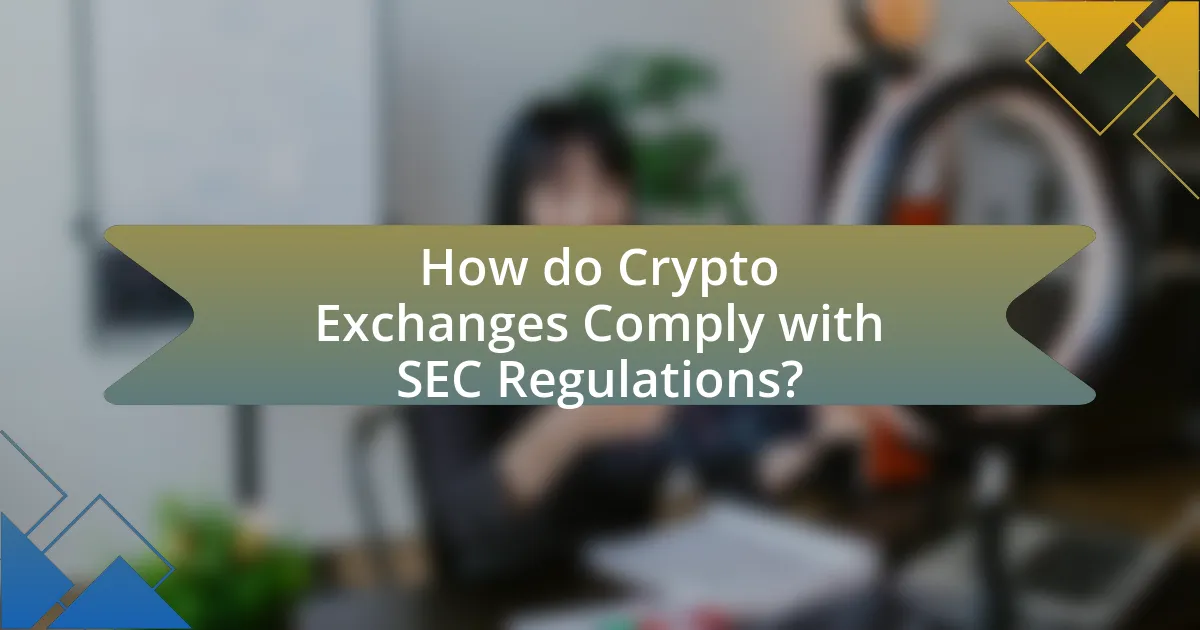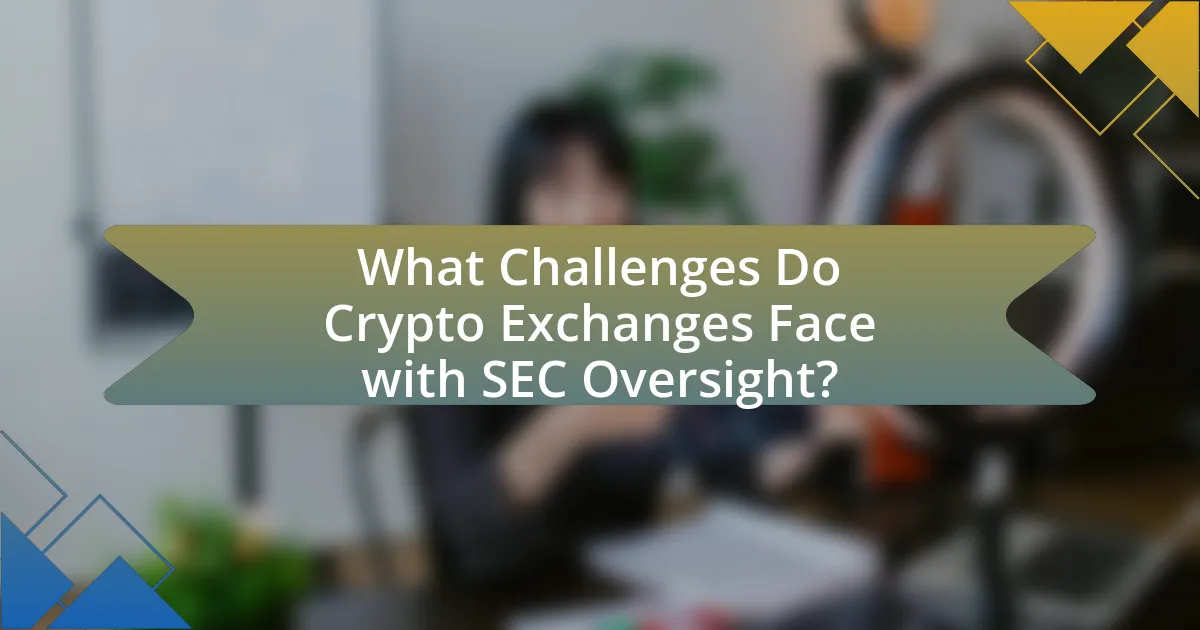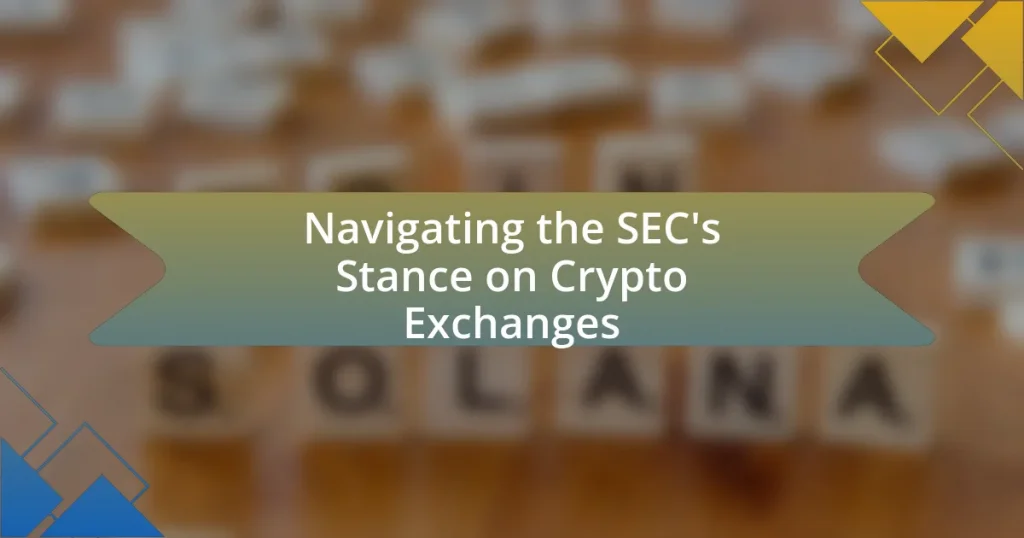The article focuses on the Securities and Exchange Commission’s (SEC) stance on cryptocurrency exchanges, emphasizing that these platforms must register as securities exchanges if they facilitate trading in securities. It outlines the SEC’s definitions and criteria for classifying crypto exchanges, the implications of these classifications on the crypto market, and the regulatory challenges faced by exchanges. The article also discusses recent enforcement actions taken by the SEC against major exchanges like Binance and Coinbase, the compliance requirements imposed on these platforms, and the strategies they employ to navigate the evolving regulatory landscape. Additionally, it highlights the importance of investor protection and the financial burdens compliance can impose on exchanges.
What is the SEC’s Stance on Crypto Exchanges?
The SEC’s stance on crypto exchanges is that they are subject to federal securities laws and must register as securities exchanges if they facilitate trading in securities. This position is based on the SEC’s interpretation that many cryptocurrencies qualify as securities under the Howey Test, which assesses whether an investment contract exists. The SEC has taken enforcement actions against several crypto exchanges for operating without proper registration, emphasizing the need for compliance to protect investors and ensure market integrity.
How does the SEC define crypto exchanges?
The SEC defines crypto exchanges as platforms that facilitate the buying, selling, and trading of cryptocurrencies and digital assets. These exchanges are considered to be operating as securities exchanges under the Securities Exchange Act of 1934 if they meet certain criteria, such as providing a marketplace for the trading of securities. The SEC has emphasized that many cryptocurrencies may be classified as securities, thus subjecting exchanges that list them to regulatory oversight. This definition aligns with the SEC’s broader mandate to protect investors and maintain fair and efficient markets.
What criteria does the SEC use to classify crypto exchanges?
The SEC classifies crypto exchanges primarily based on whether they facilitate the trading of securities. The determination hinges on the nature of the assets being traded and whether they meet the definition of a security under the Howey Test, which assesses if an investment contract exists. Additionally, the SEC evaluates the operational structure of the exchange, including whether it acts as a broker-dealer or an alternative trading system. This classification is supported by the SEC’s regulatory framework, which aims to protect investors and ensure market integrity.
How does the SEC’s definition impact the crypto market?
The SEC’s definition of securities significantly impacts the crypto market by determining which cryptocurrencies are classified as securities and thus subject to regulatory oversight. This classification affects how crypto projects can raise funds, as those deemed securities must comply with stringent registration requirements, potentially limiting their ability to operate freely. For instance, the SEC’s actions against companies like Ripple Labs, which faced legal challenges over the classification of XRP as a security, illustrate the regulatory risks that can arise from this definition. Consequently, the SEC’s stance can lead to increased compliance costs for crypto firms and may deter new projects from entering the market, ultimately influencing market dynamics and investor confidence.
Why is the SEC’s stance important for crypto exchanges?
The SEC’s stance is crucial for crypto exchanges because it establishes regulatory clarity and compliance requirements that directly impact their operations. By defining which cryptocurrencies are classified as securities, the SEC influences how exchanges list and trade these assets, thereby affecting their legal standing and market access. For instance, in 2021, the SEC’s actions against certain exchanges for listing unregistered securities highlighted the risks involved, prompting exchanges to adapt their practices to avoid penalties. This regulatory oversight ensures investor protection and market integrity, making the SEC’s position a key factor in the operational framework of crypto exchanges.
What are the potential consequences of SEC regulations on crypto exchanges?
The potential consequences of SEC regulations on crypto exchanges include increased compliance costs, reduced market participation, and potential market consolidation. Increased compliance costs arise as exchanges must implement robust systems to adhere to regulatory requirements, which can strain smaller platforms financially. Reduced market participation may occur as stricter regulations deter new entrants and investors, leading to decreased liquidity and innovation in the market. Additionally, market consolidation could result as larger exchanges absorb smaller ones unable to meet regulatory demands, ultimately reducing competition and consumer choice. These consequences reflect the SEC’s aim to enhance investor protection and market integrity, but they also pose challenges for the evolving crypto landscape.
How do SEC regulations affect investor protection in crypto trading?
SEC regulations enhance investor protection in crypto trading by imposing requirements for transparency, registration, and compliance with securities laws. These regulations mandate that crypto exchanges register as securities exchanges if they facilitate trading of securities, thereby ensuring that investors receive essential information about the assets they are trading. For instance, the SEC’s enforcement actions against unregistered exchanges have underscored the importance of regulatory compliance, which helps mitigate risks such as fraud and market manipulation. Additionally, the SEC’s guidelines on initial coin offerings (ICOs) clarify which tokens are considered securities, further protecting investors by ensuring that they are informed about the risks associated with their investments.
What recent actions has the SEC taken regarding crypto exchanges?
The SEC has recently intensified its regulatory scrutiny of crypto exchanges by filing multiple enforcement actions against several platforms for alleged violations of securities laws. For instance, in 2023, the SEC charged Binance and Coinbase for operating unregistered exchanges and offering unregistered securities, highlighting the agency’s commitment to enforcing compliance within the cryptocurrency sector. These actions underscore the SEC’s focus on protecting investors and ensuring that crypto exchanges adhere to existing financial regulations.
What enforcement actions has the SEC initiated against specific exchanges?
The SEC has initiated enforcement actions against several cryptocurrency exchanges, including Binance and Coinbase. In June 2023, the SEC filed a lawsuit against Binance, alleging that it operated an unregistered securities exchange and engaged in deceptive practices. Similarly, in the same month, the SEC also sued Coinbase, claiming that it offered unregistered securities through its platform. These actions reflect the SEC’s ongoing efforts to regulate the cryptocurrency market and ensure compliance with federal securities laws.
How have these actions influenced the operations of crypto exchanges?
The actions taken by regulatory bodies, particularly the SEC, have significantly influenced the operations of crypto exchanges by imposing stricter compliance requirements and increasing scrutiny. As a result, many exchanges have had to enhance their Know Your Customer (KYC) and Anti-Money Laundering (AML) protocols to meet regulatory standards, which has led to increased operational costs and complexity. For instance, following the SEC’s enforcement actions, several exchanges reported a rise in compliance expenditures by up to 30%, reflecting the need for robust legal frameworks and risk management systems to avoid penalties. This regulatory pressure has also prompted exchanges to delist certain cryptocurrencies deemed as securities, further shaping their trading offerings and market strategies.

How do Crypto Exchanges Comply with SEC Regulations?
Crypto exchanges comply with SEC regulations primarily by registering as securities exchanges or broker-dealers when they facilitate the trading of securities. This registration requires adherence to strict reporting, operational, and compliance standards set forth by the SEC, including anti-money laundering (AML) and know your customer (KYC) protocols. For instance, in 2021, the SEC emphasized that many tokens traded on these platforms qualify as securities under the Howey Test, necessitating compliance with securities laws. Additionally, exchanges often implement robust internal controls and risk management practices to ensure ongoing compliance and to protect investors, as highlighted by the SEC’s enforcement actions against non-compliant platforms.
What are the key compliance requirements for crypto exchanges?
The key compliance requirements for crypto exchanges include Anti-Money Laundering (AML) regulations, Know Your Customer (KYC) protocols, and adherence to securities laws. Crypto exchanges must implement AML measures to detect and report suspicious activities, ensuring they do not facilitate money laundering or terrorist financing. KYC protocols require exchanges to verify the identities of their users, which helps prevent fraud and enhances regulatory oversight. Additionally, exchanges must comply with securities laws, which may involve registering with the SEC if they offer securities or operate as broker-dealers. These requirements are essential for maintaining regulatory compliance and fostering trust in the cryptocurrency market.
How do exchanges implement Know Your Customer (KYC) regulations?
Exchanges implement Know Your Customer (KYC) regulations by requiring users to provide personal identification information before they can trade or withdraw funds. This process typically includes collecting data such as full name, address, date of birth, and government-issued identification, which is then verified against official databases to confirm the user’s identity. According to a report by Chainalysis, over 90% of cryptocurrency exchanges have adopted KYC measures to comply with regulatory requirements and mitigate risks associated with money laundering and fraud.
What role does Anti-Money Laundering (AML) play in compliance?
Anti-Money Laundering (AML) plays a critical role in compliance by establishing frameworks and regulations that prevent illicit financial activities within financial systems, including crypto exchanges. AML regulations require institutions to implement measures such as customer due diligence, transaction monitoring, and reporting suspicious activities to authorities, thereby mitigating risks associated with money laundering and terrorist financing. For instance, the Financial Crimes Enforcement Network (FinCEN) mandates that cryptocurrency exchanges register as money services businesses and adhere to AML requirements, which enhances transparency and accountability in the sector. This regulatory oversight is essential for maintaining the integrity of financial markets and fostering trust among users and investors.
How do exchanges adapt to changing SEC guidelines?
Exchanges adapt to changing SEC guidelines by implementing compliance measures, updating their operational protocols, and enhancing their legal frameworks. For instance, when the SEC introduced stricter regulations regarding the classification of digital assets, exchanges revised their listing processes to ensure that only compliant tokens were offered. Additionally, many exchanges have invested in legal counsel and compliance teams to interpret and respond to new regulations effectively, ensuring they meet the SEC’s requirements for transparency and investor protection. This proactive approach is evidenced by the increased number of exchanges obtaining licenses and registrations to operate legally within the U.S. regulatory framework, demonstrating their commitment to adhering to SEC guidelines.
What strategies do exchanges use to stay compliant with evolving regulations?
Exchanges employ several strategies to stay compliant with evolving regulations, including implementing robust compliance programs, conducting regular audits, and engaging with regulatory bodies. These compliance programs often involve Know Your Customer (KYC) and Anti-Money Laundering (AML) procedures to verify user identities and monitor transactions for suspicious activity. Regular audits help ensure adherence to regulatory standards and identify areas for improvement. Additionally, exchanges often participate in discussions with regulators to stay informed about upcoming changes and to advocate for favorable regulatory conditions. This proactive engagement is crucial, as it allows exchanges to adapt quickly to new requirements and maintain their operational licenses.
How do exchanges communicate compliance efforts to users?
Exchanges communicate compliance efforts to users through transparent disclosures, educational resources, and regular updates on regulatory changes. These platforms often publish compliance reports and guidelines on their websites, detailing their adherence to legal standards and best practices. For instance, many exchanges provide information about their Know Your Customer (KYC) and Anti-Money Laundering (AML) policies, which are essential for regulatory compliance. Additionally, exchanges may utilize newsletters, social media, and in-app notifications to inform users about new compliance measures or changes in regulations, ensuring that users are aware of their commitment to maintaining a secure and compliant trading environment.

What Challenges Do Crypto Exchanges Face with SEC Oversight?
Crypto exchanges face significant challenges with SEC oversight, primarily due to regulatory uncertainty and compliance costs. The SEC’s evolving stance on what constitutes a security complicates the operational framework for exchanges, as they must navigate a landscape where many cryptocurrencies may fall under securities regulations. This uncertainty can lead to increased legal risks and potential enforcement actions, as seen in cases where exchanges have faced lawsuits for listing tokens deemed securities without proper registration. Additionally, the financial burden of implementing compliance measures, such as Know Your Customer (KYC) and Anti-Money Laundering (AML) protocols, can strain resources, particularly for smaller exchanges. These challenges highlight the need for clearer regulatory guidelines to foster a more stable environment for crypto trading.
What are the main challenges in navigating SEC regulations?
The main challenges in navigating SEC regulations include the complexity of compliance requirements, the evolving nature of regulatory interpretations, and the lack of clarity regarding the classification of digital assets. Compliance requirements are intricate, often requiring firms to understand and implement various rules that can change frequently. The SEC’s interpretations of existing laws can shift, making it difficult for companies to stay aligned with regulatory expectations. Additionally, the classification of cryptocurrencies and tokens as securities or commodities remains ambiguous, leading to uncertainty in how to approach regulatory obligations. This ambiguity can result in legal risks and potential penalties for non-compliance, as evidenced by the SEC’s enforcement actions against several crypto exchanges for failing to register as securities exchanges.
How do regulatory uncertainties impact exchange operations?
Regulatory uncertainties significantly hinder exchange operations by creating an unpredictable environment that affects compliance and strategic planning. Exchanges may face increased operational costs due to the need for enhanced legal consultations and compliance measures to navigate ambiguous regulations. For instance, the SEC’s evolving stance on cryptocurrency classification can lead to sudden changes in operational requirements, compelling exchanges to adapt quickly or risk penalties. This unpredictability can deter investment and innovation within the sector, as firms may hesitate to launch new products or services without clear regulatory guidance.
What financial burdens do compliance requirements impose on exchanges?
Compliance requirements impose significant financial burdens on exchanges, primarily through increased operational costs, legal fees, and technology investments. Exchanges must allocate substantial resources to ensure adherence to regulations, which often includes hiring compliance officers, legal advisors, and investing in advanced technology for monitoring transactions and reporting. For instance, a 2021 report indicated that compliance costs could account for up to 10% of an exchange’s total operating expenses. Additionally, non-compliance can lead to hefty fines and legal penalties, further straining financial resources. These factors collectively create a challenging financial landscape for exchanges operating under stringent regulatory frameworks.
How do exchanges respond to SEC enforcement actions?
Exchanges typically respond to SEC enforcement actions by implementing compliance measures, enhancing their regulatory frameworks, and sometimes contesting the actions through legal channels. For instance, following enforcement actions, exchanges may increase their transparency and reporting practices to align with SEC regulations. Additionally, some exchanges have opted to engage in dialogue with the SEC to clarify regulatory expectations and seek guidance on compliance. Historical examples include exchanges like Coinbase, which have publicly addressed SEC concerns and adjusted their operations accordingly to mitigate risks associated with enforcement actions.
What legal strategies do exchanges employ to contest SEC actions?
Exchanges contest SEC actions primarily through legal strategies such as challenging jurisdiction, asserting First Amendment rights, and filing for administrative hearings. By questioning the SEC’s authority, exchanges argue that the agency may not have jurisdiction over certain activities or assets, particularly in the context of decentralized finance. Additionally, exchanges often invoke First Amendment protections to defend their right to free speech in communications about digital assets. Filing for administrative hearings allows exchanges to present their case before an administrative law judge, potentially leading to a more favorable outcome than in federal court. These strategies are supported by historical instances where exchanges successfully negotiated settlements or altered regulatory approaches through legal challenges.
How do exchanges rebuild trust with users after enforcement actions?
Exchanges rebuild trust with users after enforcement actions by implementing transparent communication, enhancing security measures, and demonstrating compliance with regulatory standards. Transparent communication involves openly addressing the enforcement actions, explaining the reasons behind them, and outlining steps taken to rectify issues. Enhancing security measures includes adopting advanced technologies and protocols to protect user assets, which can be evidenced by increased investments in cybersecurity. Demonstrating compliance with regulatory standards involves actively engaging with regulators and ensuring adherence to legal requirements, which can be validated by obtaining necessary licenses and certifications. These actions collectively help restore user confidence and foster a more trustworthy environment.
What best practices can crypto exchanges adopt to align with SEC expectations?
Crypto exchanges can adopt several best practices to align with SEC expectations, including implementing robust compliance programs, conducting regular audits, and ensuring transparent reporting. A strong compliance program should encompass Know Your Customer (KYC) and Anti-Money Laundering (AML) protocols, which help mitigate risks associated with illicit activities. Regular audits by independent third parties can verify adherence to regulatory standards and enhance trust among users. Additionally, transparent reporting of financial activities and operational practices can foster accountability and demonstrate commitment to regulatory compliance. These practices are essential as the SEC emphasizes investor protection and market integrity in its regulatory framework.
How can exchanges enhance transparency and communication with regulators?
Exchanges can enhance transparency and communication with regulators by implementing robust reporting frameworks and regular audits. These frameworks ensure that exchanges provide timely and accurate data regarding their operations, trading volumes, and compliance with regulations. For instance, the Financial Action Task Force (FATF) recommends that exchanges adopt Anti-Money Laundering (AML) and Know Your Customer (KYC) practices, which can facilitate better communication with regulatory bodies. Additionally, establishing dedicated compliance teams that engage proactively with regulators can foster a collaborative relationship, allowing for real-time feedback and adjustments to regulatory requirements. This approach not only builds trust but also aligns the exchanges’ operations with regulatory expectations, thereby reducing the risk of non-compliance.
What proactive measures can exchanges take to mitigate regulatory risks?
Exchanges can mitigate regulatory risks by implementing robust compliance programs that include Know Your Customer (KYC) and Anti-Money Laundering (AML) procedures. These measures ensure that exchanges verify the identities of their users and monitor transactions for suspicious activity, aligning with regulatory expectations. For instance, the Financial Action Task Force (FATF) guidelines emphasize the importance of KYC and AML practices in reducing the risk of illicit activities, which can lead to regulatory scrutiny. Additionally, exchanges can engage with regulators proactively to stay informed about evolving regulations and demonstrate their commitment to compliance, thereby fostering a cooperative relationship that can help mitigate risks.















